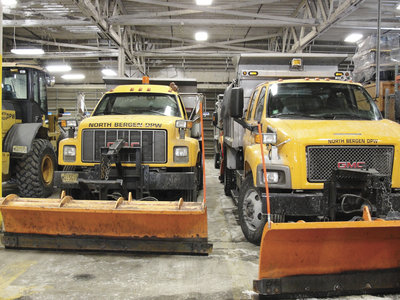“This is one of the worst winters in a long time,” said John Shaw, superintendent of North Bergen’s Department of Public Works, last week. “What makes it really bad is the temperature. Because usually you get a normal storm, you get two to three inches, four inches, five inches. The next day you get 35, 40 degree weather. It melts. With this weather it just doesn’t go away.”
Last week, Shaw and Mayor Nicholas Sacco talked about the township’s attack plan for snowstorms, just as another one loomed this past Thursday.
In North Bergen, keeping the roads clear is especially challenging because there are so many hills.
“Everybody says we’re the second hilliest in the U.S. next to San Francisco. We’ve got hills all way from 95th Street all the way down to Fifth Street on our western slope,” Shaw said. “So we have special trucks that we use for the hills. They call them Oshkosh trucks. They have what they call four-wheel turning radius. All four wheels turn, front and back, so we can make sharp turns on the hills and tight areas. They carry about four tons of salt each.”
The town has 14 pieces of equipment designated for snow removal: 10 large trucks and four smaller ones for the tighter streets. Six of the vehicles are Oshkosh trucks.
About 20 people work per shift during storms, with all trucks hitting the roads simultaneously.
Prepping for action
“Before a storm we put down brine on the streets,” said Shaw. “When the salt hits the brine it works that much better. That gives us like two hours into the storm. After that it wears out.”
Also supplementing the salt is calcium chloride, loaded into tanks on the side of the trucks. “The reason we have those is because when the temperature drops down to 15 below, salt doesn’t work very well,” he said. “So if we mix it with the calcium chloride it works much better.”
Before a storm the DPW monitors the weather closely using all available channels.
“We have a large meeting of all the different people involved, from the public works director to the Health Department to police and fire, the parks department and schools,” said Mayor Nicholas Sacco. “So when storms are coming we can attack as a team.”
“We monitor right up until the storm,” said Shaw. “We usually bring our men in at least two hours to an hour earlier than what they predict. If they say it’s going to start at 12 our guys will be here by 10:30. We move all the vehicles out, check whatever we have to check, make sure all the tires are okay, back them up, load them up. Every single vehicle is lined up out here with the lights going and everything. And then as soon as the flakes start coming down we hit the roads. It’s pretty impressive.”
“We’ve got the best equipment in the world.” – John Shaw
____________
Men go out for six hours at a time and come back for staggered breaks. While the workers are grabbing a bite to eat or some coffee, the trucks are cleaned and readied for the next trip, then the same crew takes them out for another six hours.
Fighting the storm
Shaw started as superintendent of the DPW in September of 2012. Before that, “I was a superintendent for 27 years in the sanitation department. Since Mayor Sacco’s come in, any piece of equipment we need, we get it. We’ve got the best equipment in the world. We’re in the process right now of purchasing a piece of equipment to fill potholes.”
In addition to the best trucks, North Bergen utilizes the best technology to combat the weather. “During the storms we have GPS systems here on my computer,” said Shaw. “I can watch all the vehicles at the same time out there on the street.”
During a storm they also make use of the OEM command center next door. The command center monitors 150 cameras.
“This was really instrumental during Sandy,” said Shaw. “Usually the police use it but it’s great for DPW during storms.”
In addition, “We have conference calls all through the night,” said Mayor Sacco.
“We coordinate with everybody,” said Shaw. “The mayor’s strictly on top of that. The mayor will check in and there’ll be like 14 of us on the conference call. And he wants an update all the time.”
Low on salt
Since North Bergen contains county and state roads as well, the town recently offered to let the county use the DPW lot for some of their trucks so they wouldn’t have to continually drive back to Jersey City to reload salt. North Bergen now replenishes the county trucks with salt, and the county reimburses the town for the cost.
“This year we used about 7,000 tons of salt [so far],” Mayor Sacco said midweek, before the most recent storm hit. “Normal is 4,000 tons per season. We’re well over that.”
With the recent run of back-to-back storms, maintaining the stock of salt has become an issue not only locally but throughout the country.
“We, for the first time in a very long time, are running low on salt,” said Shaw. “We’re at a 50 percent mark right now. We will be rationing what we put out on the street. We actually have 2,400 tons on order. We’re expecting somewhere around 430 tons in the next two days…Everybody’s begging for salt. But we won’t drop the ball. We won’t let the services go down. We’re ready for anything.”
Art Schwartz may be reached at arts@hudsonreporter.com.
